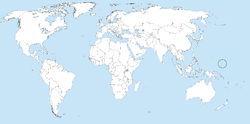Nauru reed warbler
| Nauru reed warbler | ||||||||||||
|---|---|---|---|---|---|---|---|---|---|---|---|---|
| Systematics | ||||||||||||
|
||||||||||||
| Scientific name | ||||||||||||
| Acrocephalus rehsei | ||||||||||||
| ( Finsch , 1883) |
The Nauru warbler ( Acrocephalus rehsei ; Nauru : itsirir ) is a small songbird belonging to the warbler family . It occurs exclusively on the west Pacific island of Nauru and is therefore endemic there . The Nauru warbler is the only songbird in Nauru; little is known about him in general. It has been classified as "endangered" because of its low distribution potential dangers such as cyclones or the introduction of foreign predators.
The Nauru reed warbler is about 15 centimeters long and a gray-brown reed warbler with a thin, straight beak. Above its plumage is gray-olive-colored, on the belly ivory-colored with white eyebrows. Nothing has been reported about its vocal sounds, but it can be assumed that it utters sounds similar to those of most of the Pacific reed warriors.
The population is estimated to be less than 10,000 individuals. There is no information about changes in population size. The species is widely distributed all over the island. A concentration is mainly to make out the Buada lagoon .
The Nauru warbler appears mainly in the rest of the forest on the steep slopes of the central plateau, but is also often seen in the gardens on the coast and in the regenerating areas of the former phosphate mines in the central plateau . In the coastal zone he looks for insects in the tops of the coconut palms .
Almost 80 years of phosphate mining in Nauru caused devastating environmental damage and significantly restricted the habitat of the Nauru reed warbler, but the phosphate reserves are now exhausted and the Nauru reed warbler was able to repopulate the regenerating phosphate fields. Other threats, such as introduced rats or snakes , which have caused large declines in the reed warbler population on other Pacific islands, are not known.
Web links
- Acrocephalus rehsei in the endangered Red List species the IUCN 2008. Posted by: BirdLife International, 2008. Accessed January 31 of 2009.
